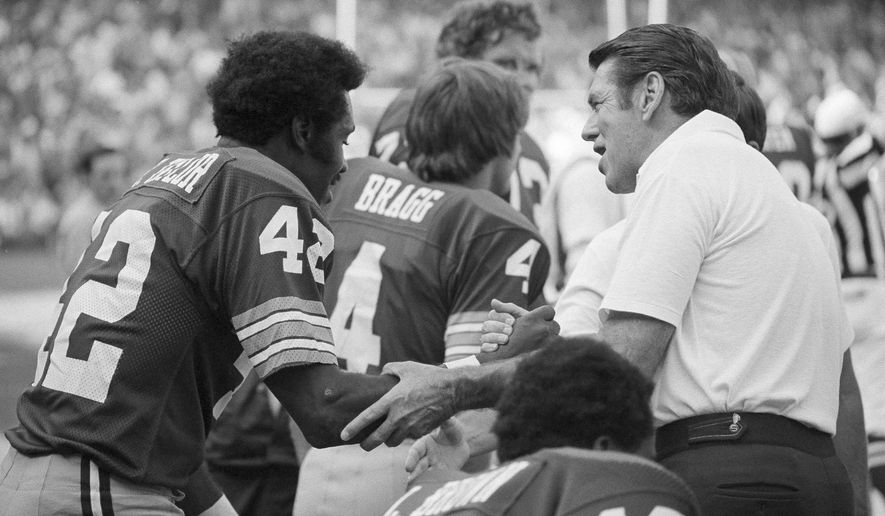If you believe in heaven, then trust me: I know what Charley Taylor is doing today. He’s sitting by the side of a celestial stream, somewhere up there, fishing for trout.
The Washington great, looking back on the team’s annual training camps in Carlisle, Pennsylvania, and the trout fishing he enjoyed there, told me how much that time meant to him.
“I loved to fish, and they had a great trout stream there,” Taylor said. “I was in heaven to have that there.”
Watching Taylor was heaven for Washington football fans.
Taylor, who passed away Saturday at the age of 80, was a powerful dancer on the field. Drafted as a running back out of Arizona State in 1964 and then shifted to wide receiver, Taylor went on to forge a Hall of Fame legacy before he was done catching passes in 1977 — 649, the most of any pass catcher in NFL history at the time. Seven years later, Taylor found himself in Canton.
“As a kid who loved football, I watched the Washington teams of the 1970s compete at a high level and quickly became a fan of the player wearing No. 42,” said Pro Football Hall of Fame President Jim Porter. “He seemed to make everything look so easy.”
It was anything but.
Taylor was a two-time All-American running back at Arizona State — he was inducted into the Arizona State Sports Hall of Fame in 1975 as a charter member — but when he came to Washington as a first-round draft pick, coach Otto Graham wanted him to change positions.
“He (Graham) wanted to go with the big full backfield, so he had a chance to pick up Joe Don Looney and Steve Thurlow,” Taylor told me in an interview for my book, “Hail Victory.”
“He wanted to move me out,” Taylor said. “But it was good for me because I was having problems blocking. It gave me a chance to get out and be free and do what I do naturally.”
Veteran quarterback Sonny Jurgensen arrived in Washington from Philadelphia the same year as Taylor. The two of them would be the foundation of one of the greatest offenses of the decade,
“We had a strong offense for the first four years I was there,” Taylor said. “I don’t think there was anybody in the league that could compete with us offensively. We had a guy who had a great arm and no fear. We were unstoppable offensively.
“But we would lose ball games 35-33, that type of thing,” Taylor said. “It was just that we couldn’t stop anybody. Our defense wasn’t that bad. We just had some holes we couldn’t shore up. We had some great defensive players.”
Taylor had a particular memory of that historic 72-41 win over the New York Giants on Nov. 25, 1966 — the most points scored in an NFL game. It should have been more.
“The 72-41 game, it should have been 79,” Taylor told me. “I dropped a sure touchdown. I remember that vividly. I felt this guy on my shoulder as I dropped the ball and after the ball had fallen to the ground, I looked over and it was the official running along with me. It sort of distracted me.’
Washington fans who lived through that golden offensive era could see that neither the defense nor the team’s coaches were on par with what the Jurgenssn-led offense was doing.
Like so many of the players who were here in 1969, Taylor raved about the impact Vince Lombardi had in his one season as the Washington coach before his death in 1970 from cancer.
“When Lombardi got here, and with the people we had in place here already, he turned that team around,” Taylor said. “He taught us how to win. He would get the most out of every athlete he had. He knew their limits. He knew how far to push them. He just had a great feel for talent and his people. And he was a fair man. He was tough, but you knew that and expected it.”
Their success would continue with George Allen, culminating in the 1972 NFC championship game against Dallas, a 26-3 victory. Taylor caught seven passes for 146 yards and two touchdowns from Billy Kilmer. “The 26-3 game over Dallas was one of my finest games as a football player,” he said. “Everything was so easy for me on that day, it all came so smooth.”
Born in Grand Prairie, Texas, Taylor would explain to me perhaps better than anyone what the Cowboys rivalry meant to the players.
“The Redskins-Cowboys rivalry was down to the bone, down to the marrow,” he said. “My mom would get threatening phone calls. It was always a very intense series. Half our ball club was from Texas, so it was like a homecoming. All the family and friends would be there at the stadium. All the guys from Texas had to produce because we had to live down there in the offseason.”
But Taylor loved playing in Washington, and appreciated the team’s fans. He spoke fondly of the 1975 season finale 26-3 loss to the Philadelphia Eagles, when he broke Don Maynard’s record of 634 career catches.
“After I caught the pass to set the all-time record, everybody (at RFK Stadium) left the stands,” he said. “We still had about 10 minutes left the play. We were playing the Eagles and it was a drizzly day. People hung around until that happened and I appreciated that.”
Washington fans always appreciated Charley Taylor. They always will.
Hear Thom Loverro on The Kevin Sheehan Show podcast.
• Thom Loverro can be reached at tloverro@washingtontimes.com.




Please read our comment policy before commenting.